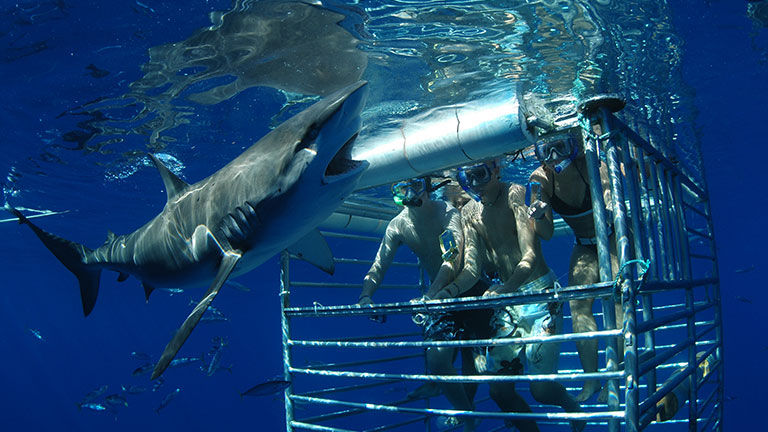It was impossible to stop the "Jaws" soundtrack from playing on repeat in my head as our boat left Haleiwa Harbor, on Oahu’s North Shore, and headed toward open water. Somehow my 23-year-old daughter, lucky enough to live on the island, had convinced me that going swimming with sharks was a good idea.
“You’d love it,” she had said in a text. And after seeing the stunning photos taken during a previous outing with Hawaii Ocean Adventure Tours, I couldn’t argue. But now that the moment had arrived, I questioned what I’d gotten myself into.
“I think sharks are one of the most misunderstood creatures on the planet,” said Captain Ryan Bruner, owner of Hawaii Ocean Adventure Tours. “I’ve been swimming with [sharks] for 15 years. I’ve probably got 5,000-plus dives under my belt with them, and I’ve never had a situation where I felt threatened.”
With sea spray hitting our faces, the captain and solo deckhand/safety diver fitted us with snorkel gear and went over the rules: Be aware of your surroundings, stay calm and be respectful to the animals. In other words, no touching.
The tour starts with a quick 15-minute or so boat ride, as the prime spot to swim with sharks is located just three miles off the coast from Haleiwa. We had company — a lively handful of Galapagos sharks — swimming in the boat’s wake before we even made it to the site. There’s no chumming or luring the sharks with food. After decades of crabbing and fishing in these waters, sharks now naturally follow boats, associating the whirl of motors with a possible free lunch.
“It’s like Pavlov’s dogs,” Bruner said. “I call it Pavlov’s sharks, but it’s classic conditioning. Instead of a bell, it’s a boat motor, and instead of dogs it’s sharks. Food is that constant. They’re just conditioned to any boat in the area being a food source.”
Knowing we had an audience, the captain told us to get our masks and snorkels on and be ready with fins in hand. First in was the safety diver. Once getting the all-clear, our small group of four quietly entered the water. Our original handful of shark followers had grown to approximately four dozen strong, and now circled 10 to 20 feet below. I could barely breathe, but not out of fear. Watching the growing crowd glide effortlessly through the water was more captivating than I ever could have imagined.
Oahu’s North Shore is home to a variety of shark species. A majority of the sharks that snorkelers see in the 300-plus-foot water are Galapagos sharks, but scalloped hammerhead, oceanic blacktip and sandbar sharks are also common. July through October is the season for spotting tiger sharks. Bruner says he has also seen whales, and recently spotted a whale shark on a tour.
“Sharks feed on small things; they don’t look at us as a food source,” Bruner said. “Sharks generally view humans as a potential predator, and they want to give you a buffer zone as well, so you don’t reach out and try to bite them.”
For clients who are understandably hesitant to dive in the water with an apex predator unprotected, another operator, Hawaii Shark Encounters, has been offering shark swims in cages for about 20 years.
 On a cage diving tour, clients can get very close to the sharks.
On a cage diving tour, clients can get very close to the sharks.
Credit: 2021 Hawaii Shark Encounters“In the cage, the sharks can get really close to you, safely,” said Reece Williams, co-owner of Hawaii Shark Encounters. “Diving with these animals in their natural habitat, our customers can see that these are beautiful creatures that should be protected, not feared.”
Ultimately, comfort level plays a large role when helping a client choose the tour that’s best for them, but there are other differences to take into consideration, as well.
Diving with these animals in their natural habitat, our customers can see that these are beautiful creatures that should be protected, not feared.
Hawaii Ocean Adventure Tours caps its shark swims to six guests, and everyone gets in the water at the same time. Hawaii Shark Encounters takes 12 people at a time, but splits the group in two. While six people are in the water, the rest watch from above. Though more time out on the water is a plus for some, those prone to sea sickness should be prepared.
Clients should bring a towel, sunscreen, water and a waterproof camera if they have one. Snorkel gear is provided. (No scuba experience is necessary.)
Before starting Hawaii Ocean Adventure Tours, Bruner spent time working on shark cage tour boats as well. He encourages folks to forget about all those images of sharks they’ve seen in movies and on television and get in the water any way they can.
“No matter how you do it, it’s a good experience,” he said.
The Details
Hawaii Ocean Adventure Tours
Hawaii Shark Encounters